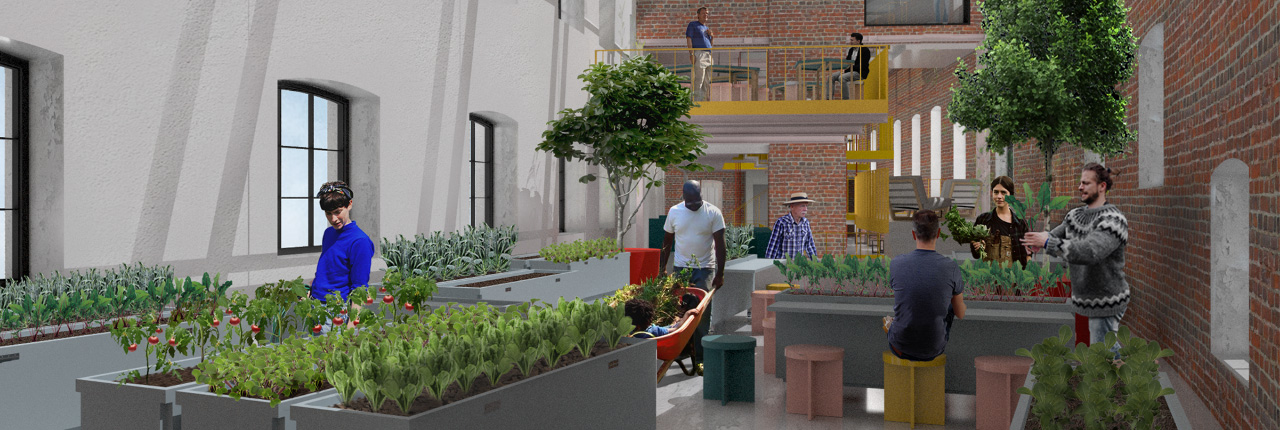BA Interior Design student Fiona Fuller has been based at her parents’ home for the duration of lockdown. With a laptop and some model-making equipment, she has been able to set up a home working space in a spare bedroom.
We asked Fiona to tell us more about her design practice and her innovative community-building project that brings people together through growing food.

Can you describe your practice?
In my design practice I look to what works now, what is lacking and how I can build on that relationship to create for the future. My current focus is on social design practices and co-created public spaces that ignite the conversation of change. I’m also interested in how we operate as individuals and as communities and how that can be a positive influence in how we design cities in the future.
How have you adapted your practice for working outside of the studio?
I have had to rethink how I wanted to showcase the final narrative of my project. Normally I would use the laser cutting machine and the computers in the digital studio to create high res renders and models, but as I didn’t have the means to use them during this period, I had to really plan my time around how much my laptop could do and cope with. I left my laptop on a lot overnight to produce a digital render by the morning. There were times when I thought it was going to overheat and die from the amount of time I was using it in the final months before submission!
Have these circumstances resulted in any unexpected opportunities, for example, a collaboration or a change in your usual practice and the materials you use?
It has made me appreciate how much inspiration you can get from 1:1 interactions in a studio environment. There were so many times when I felt my project wasn’t progressing and I felt like I was stuck in a rut. There’s only so much help you can get through an online tutorial so I will really appreciate getting back into working around other people, because you pick up on different things that they are doing and that organically leads your own project in a different direction.
Please tell us more about your graduate project?
My project is called The Open Assembly, and it is centred around community ownership, communication and collaboration. It is an interior project set within the new regeneration site of Kings Cross, London. By offering a ‘system of support’ for the more vulnerable groups in society the project investigates a new type of interior public space, looking at produce cultivation as a way to strengthen community relationships and social and cultural values.
What were the inspirations/idea behind it?
Through site research I started to learn more about the ‘invisible’ barriers that are present from the regeneration of the site. I wanted to create a project for the groups and communities who feel ‘unwelcome’ and ‘isolated’ by the design decisions of the new site, as a building block to reconnect community relationships and rebuild citizen identity.
There are so many community and charity projects doing great things around London, but I felt that the inner site of Kings Cross was lacking a co-created space that the citizens could take responsibility for and have ownership over. That’s when I set on the idea of creating a community hub with produce cultivation as its main focus. In my design, the roof tops of the building are utilised as growing spaces.
The act of growing, maintenance and harvest of the produce then feeds down into the rest of the building, into the kitchen, cooking school and food market. The building provides a base for education, ownership, responsibility and identity to all who want to be involved.
What are the processes and materials you have used?
My course very much relies on digital programmes, so I have been using the Adobe Creative products and 3D software like Sketchup and Rhino to aid my design process and development.

Do you have any tips for students – what has helped you remain positive and keep creating during this time?
Just knowing that I only had one chance to do this project pushed me through to keep going till the end. I wanted to come out with a good project so hard work was the only thing that could make that happen.
What career paths are you considering for once you graduate?
I am going to go work on a vegetable farm for the summer. I think my future will hold a combined element of design, produce cultivation, sustainability and social practice in one form or another. I think now, especially after Covid-19, how we live and operate as individuals and as communities needs to change.
Why should students consider studying a BA in Interior Design at Chelsea?
This course offers a really varied outlook on what interior design is. You are exposed to so many different media that all relate to the process and development of projects, resulting in a unique understanding of how design is integrated into our lives. Architecture, fine art, sculpture, furniture design, photography and so many more disciplines play a huge role in this course and how you are introduced to these from the start is an invaluable asset as the foundations of your career. If you are looking for a course that exposes you to more than just interiors and that makes you more rounded as a designer, then BA ID is for you.
What has the course offered you?
The course has offered me freedom to explore beyond what is possible and to enable my imagination to be pushed further. I’ve come to learn that to break boundaries and reinvent typologies is so important for my own progression and that of interior design in the future.

